
The Standardbred
When asked what they find most remarkable about their Standardbreds as saddle horses, the answer most owners give might surprise you. It's not their speed, which for over 200 years has been the hallmark of the breed. It's not their superior athletic ability, legendary endurance or even their extraordinary versatility. Standardbred owners are often most proud of their breed's character and amazing temperament. "Tolerant, intelligent and willing, these horses take on new lifestyles and expectations with ease," states the Standardbred Pleasure Horse Organization. Like many American breeds the Standardbred is a melting pot of bloodlines. Its roots date back to the New England colonists of the 1600s and the English and Dutch horses they crossed. Some suspect a Spanish influence, as well. The result was a compact, stout, durable mount that could be ridden long distances in comfort. Though their gait was historically referred to as a "pace", the element of comfort belies it as more likely a broken pace or other soft saddle gait. Many of these horses, averaging only a little over 14 hands, were bred in Canada and shipped south. Once established in 1636, Rhode Island quickly became the horse capital of New England and the best pacers were bought, sold and bred there. Racing became popular and the breeding of swift horses became a profitable venture. In time these horses became the most popular saddle mounts and harness horses of the colonies. Though not particularly good-looking, they were surefooted, dependable, fast and comfortable to ride. Named for the Narragansett Bay, near which breeding centered, the Narragansett Pacers were the mount of choice for nearly 150 years. When the English Thoroughbred, MESSENGER, was imported to Philadelphia in 1788, shortly after the American Revolution, he sparked a revolution of his own in horse breeding. His sire, MAMBRINO, had been a star galloping racehorse in 4-mile heats. Crossed with the tough little colonial horses, MESSENGER produced offspring with great action, speed and endurance at the trot. This Thoroughbred influence also added more size and refinement. In 1849 the unlikely birth of his great-grandson, HAMBLETONIAN 10, marked the beginning of a new breed. Hambletonian's dam, a daughter of a mare named ONE EYE, who was line bred to Messenger, had been crippled in a runaway accident. His sire, ABDULLAH, was best known for his vile temperament. How their offspring became the undisputed foundation sire of sweet natured, swift, sound horses is one of the more pleasant mysteries of life. By the time the studbook was opened in 1871, horses bred for harness racing had to meet a set standard of speed in time trials to be eligible for registration; thus the name of the breed. At this point, trotters had to cover a mile in 2:30 minutes and pacers in 2:25 minutes. In 1897, pacers gained respect when STAR POINTER broke the 2 minute mile barrier, and with the famed career of DAN PATCH, who won his first race in 1900, drew crowds wherever he appeared and was one of the fastest pacers ever (1:55 for the mile) they moved into the limelight. Harness racing brought the "sport of kings" to the common man and great harness racers were adored by the masses. Horses like ROSALIND, who in 1937, drew on her amazing stamina and heart to set a new record for the All-American handicap at Syracuse (3.12 ¼ for 1 ½ miles) when started 240 feet behind the wire and like GREYHOUND, who in 1938 was the fastest trotter on record, breaking the mile at 1:55 ¼ with a 27-foot stride, were among the most popular sport heroes ever. But still, it is the heart of the horse that draws new people seeking riding mounts to the breed. Since speed was the only standard, size is variable, from 14.1hh to 17hh, though most range from 15.2 to 16. Bay is the most common color, followed by chestnut and brown, and less often grey, black or roan. Body style is similar to a Thoroughbred, though often longer, more muscular and less refined, especially about the head; convex profiles are not rare. Ears may be medium to large, nostrils flare to allow for great oxygen intake, contributing to fantastic stamina, and manes and tails are luxurious. Bred for harness, the ribcage is generally flatter, and the hindquarters sloped, characteristics that also happen to lend themselves to broken gaits, and indeed, a high percentage of Standardbreds are easily encouraged into saddle gaits. For more information contact:
United States Trotting Association,
Standardbred Pleasure Horse Organization (a national organization),
American Standardbred Adoption Program, |
|






